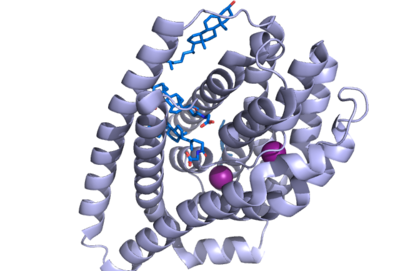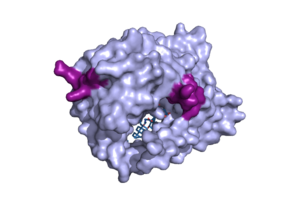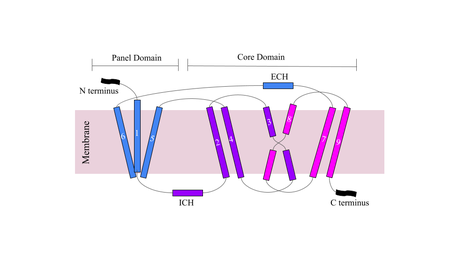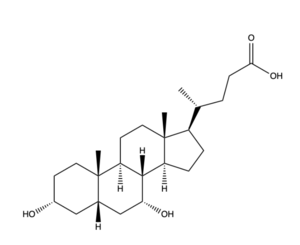Sandbox Reserved 1783
From Proteopedia
(Difference between revisions)
| Line 26: | Line 26: | ||
=== Conformation Change === | === Conformation Change === | ||
| - | [[Image:Figuredomain.png| | + | [[Image:Figuredomain.png|450 px|right|thumb|'''Figure 1.''' Cartoon of NTCP topology.]] |
The conformational change of NTCP's core domain helices are essential to bile salt binding and uptake. Figure 1 displays the topology of NTCP, highlighting both the panel (shown in blue) and core (shown in purple and pink) domains. Helices 3 and 8 are the main structural components of the conformational change. Before bile salt can bind, the pore in which salt binds must be <scene name='95/952711/Open_pore_ntcp_non_transparent/1'>open</scene>. The open pore is flipped open toward the outer membrane to allow for binding. Once <scene name='95/952711/Open_pore_with_bile_salts/1'>bound</scene>, the pore is <scene name='95/952711/Closed_pore_ntcp/1'>closed</scene>, and bile salt is able to be released into the cell, past the inner membrane. | The conformational change of NTCP's core domain helices are essential to bile salt binding and uptake. Figure 1 displays the topology of NTCP, highlighting both the panel (shown in blue) and core (shown in purple and pink) domains. Helices 3 and 8 are the main structural components of the conformational change. Before bile salt can bind, the pore in which salt binds must be <scene name='95/952711/Open_pore_ntcp_non_transparent/1'>open</scene>. The open pore is flipped open toward the outer membrane to allow for binding. Once <scene name='95/952711/Open_pore_with_bile_salts/1'>bound</scene>, the pore is <scene name='95/952711/Closed_pore_ntcp/1'>closed</scene>, and bile salt is able to be released into the cell, past the inner membrane. | ||
| Line 37: | Line 37: | ||
[[Image:Screenshot_2023-03-20_at_3.59.09_PM.png|400 px|right|thumb|'''Figure 1.''' Bile Salt Uptake Mechanism.]] | [[Image:Screenshot_2023-03-20_at_3.59.09_PM.png|400 px|right|thumb|'''Figure 1.''' Bile Salt Uptake Mechanism.]] | ||
| - | The NTCP protein goes through a conformational change when assisting in the uptake of bile salt into the cell. This is accomplished through the opening of a wide transmembrane pore, creating a transport pathway for bile salts. The mechanism includes two sodium metal ions that allow for residue stabilization when going through the conformational change. Binding of the preS1 region of the HBV/HDV virus blocks any subsequent bile salt uptake. Thus, preS1 binding blocks the conformational change and entry of any salts into the cell. Residues 8-17 of preS1 are critical for NTCP:pres1 binding. Patch 1 and Patch 2 (external) residues interact with residues 8-17 of preS1 to facilitate binding. | + | The NTCP protein goes through a conformational change when assisting in the uptake of bile salt into the cell. This is accomplished through the opening of a wide transmembrane pore, creating a transport pathway for bile salts. The mechanism includes two <scene name='95/952711/1_sodium_binding_to_ntcp/1'>sodium</scene> metal ions that allow for residue stabilization when going through the conformational change. Binding of the preS1 region of the HBV/HDV virus blocks any subsequent bile salt uptake. Thus, preS1 binding blocks the conformational change and entry of any salts into the cell. Residues 8-17 of preS1 are critical for NTCP:pres1 binding. Patch 1 and Patch 2 (external) residues interact with residues 8-17 of preS1 to facilitate binding. |
| - | + | ||
| - | + | ||
== Significance == | == Significance == | ||
Revision as of 19:44, 27 March 2023
| This Sandbox is Reserved from February 27 through August 31, 2023 for use in the course CH462 Biochemistry II taught by R. Jeremy Johnson at the Butler University, Indianapolis, USA. This reservation includes Sandbox Reserved 1765 through Sandbox Reserved 1795. |
To get started:
More help: Help:Editing |
Sodium Taurocholate Co-Transporting Peptide
| |||||||||||
References
- ↑ Goutam, K., Ielasi, F.S., Pardon, E. et al. Structural basis of sodium-dependent bile salt uptake into the liver. Nature 606, 1015–1020 (2022). DOI: 10.1038/s41586-022-04723-z.
- ↑ Maldonado-Valderrama, J., Wilde, P., Macierzanka, A., & Mackie, A. (2011). The role of bile salts in digestion. Advances in colloid and interface science, 165(1), 36–46. DOI: 10.1016/j.cis.2010.12.002.
- ↑ 3.0 3.1 3.2 Asami J, Kimura KT, Fujita-Fujiharu Y, Ishida H, Zhang Z, Nomura Y, Liu K, Uemura T, Sato Y, Ono M, Yamamoto M, Noda T, Shigematsu H, Drew D, Iwata S, Shimizu T, Nomura N, Ohto U. Structure of the bile acid transporter and HBV receptor NTCP. Nature. 2022 Jun; 606 (7916):1021-1026. DOI: 10.1038/s41586-022-04845-4.
- ↑ Liu, H., Irobalieva, R.N., Bang-Sørensen, R. et al. Structure of human NTCP reveals the basis of recognition and sodium-driven transport of bile salts into the liver. Cell Res 32, 773–776 (2022). DOI: 10.1038/s41422-022-00680-4.





